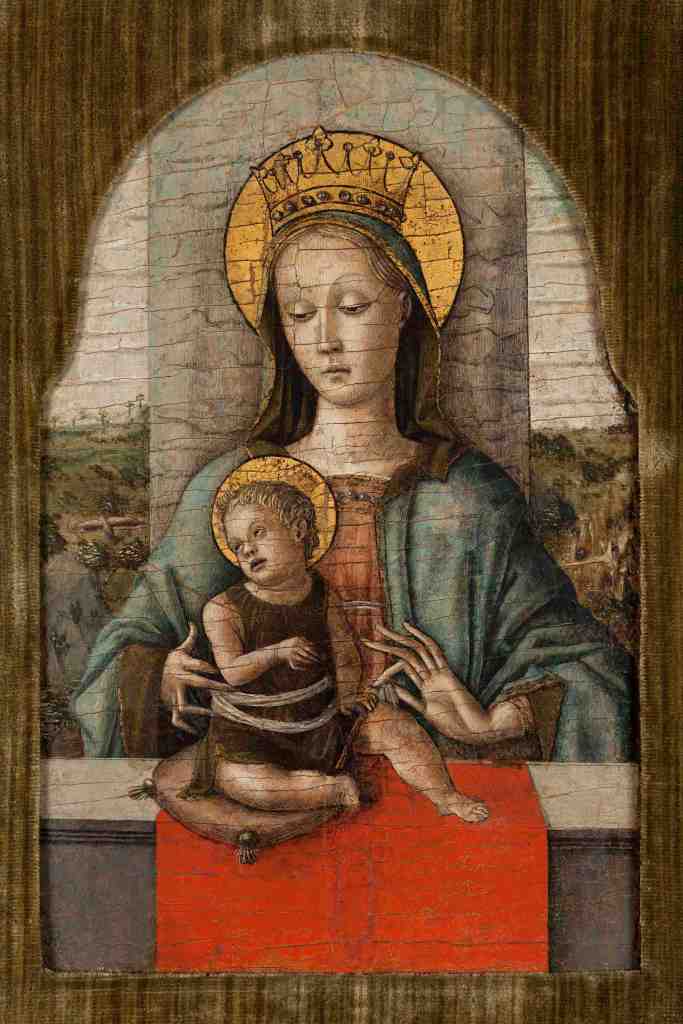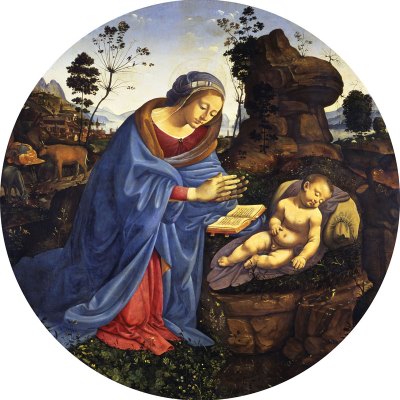The Fasti Veneziani (Venetian Glories) of Antonio Guardi is a series of some 58 pen and ink drawings celebrating the history of Venice from its founding to the mid 18th century, 37 of which were once in the collection of the great Italian collector and philanthropist Vittorio Cini (1885–1977). On these enormous sheets, measuring around 50 x 75cm, the triumphs of the city are rehearsed as if they were scenes from the rococo theatre, with their swaggering business, dramatic washes and bravura mark-making. But if the drawings make an impression of great originality, their subjects, as Giuseppe Fiocco pointed out in Le Tre Venezie (1943), are mostly taken from pre-existing paintings in the city, including cycles in the Palazzo Ducale and the Scuola Grande di San Marco. It’s easy to sense why these objects would be so desirable to a collector here: they gather together Venice’s past and its places, but find a way of making them (just about) portable – and new.
Installation view of ‘Rediscovered Masterpieces from the Vittorio Cini Collection’ at Palazzo Cini, Venice

Three albums of these drawings are currently on display at the Palazzo Cini, in ‘Rediscovered Masterpieces from the Vittorio Cini Collection: Crivelli, Titian, Lotto, Canaletto, Guardi, Tiepolo’ (until 15 November), a title that offers six convincing reasons to visit the exhibition but hardly prepares you for the triumph that it achieves through its intimate presentation and sense of novelty. Federico Zeri, one of several important art historians to have advised Cini, firmly believed that the ‘true collector’ of pittura antica did not merely go chasing big-name artists, but juxtaposed works by figures central to art-historical tradition with pieces that, for reasons of attribution or iconography, might inspire further intellectual fascination. That effect has been realised here.
In part, this is because the entire grouping of works acts as a counterpoint to what have become the more celebrated aspects of Cini’s picture collection. Widely known are his holdings of Ferrarese and Tuscan paintings, which were acquired from the 1930s onwards with the help of Nino Barbantini, Bernard Berenson and others. These have been published since his death and are now permanently displayed in the beautifully restored galleries of the piano nobile at Palazzo Cini (Cini’s residence in Venice since 1919–20, when he acquired and merged the Palazzo Grimani and Palazzo Foscari; he set up the Fondazione Giorgio Cini on the island of San Giorgio Maggiore after the death of his son in 1949). But this exhibition shifts the emphasis elsewhere: for if Cini clung dearly to the refined intellectual past of his native Ferrara, he also immersed himself in the many moods of Venice, as captured and cultivated by its artists.
Luca Massimo Barbero, the director of the Institute of Art History at the Fondazione Giorgio Cini, has brought together around 30 paintings by artists from Venice and the Veneto, all of which were once owned by Cini and are now held in other private collections. He describes mounting the exhibition as like opening a workshop for scholars, and you can see what he means, for so many of the paintings here beg further questions about their subjects, or creators, or reception histories. Most inscrutable of all, perhaps, is the large Madonna and Child flanked by St Francis and John the Baptist by Bartolomeo Montagna of c. 1485. In this sacra conversazione, the life-sized figures are depicted with a startling naturalism – the tender St Francis beside a stony-faced Virgin – against what feels like a lingering Venetian gloaming (although the condition of the painting may have something to do with that).
Madonna with Child and Saints Francis and John the Baptist (c. 1485), Bartolomeo Montagna

The exhibition is part of a wider research project on Cini’s collections, the first stage of which will culminate in the publication of a scholarly catalogue of the Palazzo Cini Gallery. But seeing these paintings on the floor above the permanent display, in galleries that follow the same plan, also provides an opportunity to consider afresh more lyrical aspects of the collection – its formal or compositional rhymes, for instance, that may not have art-historical consequence but imbue the collection with its character. I cannot help feeling that the enigmatic architectural settings and devices of Cini’s Ferrarese paintings – above all those by Ludovico Mazzolino – find their match in a grouping of Venetian Madonnas, most notable among them the Speyer Madonna of Carlo Crivelli, all structured around prominent parapets on which the Christ Child is poised.
Madonna with Child (c. 1455), Carlo Crivelli

Throughout the exhibition, there is that characteristically Venetian sense of the fixed playing off against the fleeting, which is crowned by the works of Canaletto and the Guardis, who found a type of monumentalism in the city’s ephemeral entertainments. One even senses it in the primitive works shown here, not least in a late 14th-century Madonna Enthroned by Stefano di Sant’Agnese, in which the thronged angels have a sculptural permanence but also, with their instruments and in their interactions, bring the evanescence of music and passing incident to the picture. It’s there, too, in a late gothic panel by Michele Giambono showing St Francis receiving the stigmata – the bright, perpetual wounds echoed by the berries that pock the temporal, naturalistic landscape in which the saint kneels.
Madonna and Child Enthroned (after 1385), Stefano di Sant’Agnese

If such impressions might seem like a back projection from 18th-century Venetian painting, then that too is one of the non-linear logics through which a private collection can assert its character. And indeed, the 18th-century paintings here do have this power on the visitor, viewed as they are before the earlier works in the display. Revelatory are two early capricci by Canaletto, dating to 1721–22 when the artist had recently returned from a formative trip to Rome. They transpose Roman ruins into a murky waterworld, in which the ancient stones look to be on the verge of liquefaction. A view of St Mark’s Square by Francesco Guardi, meanwhile, records the parade of allegorical floats concocted in 1782 to honour the future Tsar Paul I and his wife Maria Fëdorovna, its documentary value as record of temporary architecture giving way to an allegorical celebration of the Venetian and Russian empires.
Fantasy Landscape with Ruins and Figures (c. 1722), Canaletto

It seems apt that these works in which the permanent and the contingent seem to coalesce should be reunited for a spell in these galleries. Together, Cini’s Venetian paintings disclose his strong urge to hold on to the best of the Venetian artistic past (which is why there are no 17th-century paintings), but also its histories of devotion and display. Perhaps no works here are more striking, in terms of their capacity to reconfigure the vaunting nature of La Serenissima in the modest galleries of a house museum, than the three canvases originally painted by Antonio Guardi for the ceiling of Palazzo Zulian a San Felice, and depicting Cybele, Neptune and Vulcan as allegories of Earth, Water and Fire (Juno, or Air, is missing). With these works hung at eye level, it is the quality of the painting that becomes so apparent – the conjuring of a bouquet of flowers, or of Neptune’s trident with the most beguilingly carefree of brushstrokes.
Ceiling paintings by Giovanni Antonio Guardi, showing Venice Triumphant, Neptune, and Vulcan, installed at Palazzo Cini, Venice

The exhibition is a lesson in what remained possible in the post-war period for a dedicated collector who strove to assemble an exceptional group of Italian paintings. But it is also, in its intensity, an imaginative and scholarly exercise that should give visitors grounds to rethink Venetian art: these little-known works make the subject fresh again.
‘Rediscovered Masterpieces from the Vittorio Cini Collection’ is at Palazzo Cini, Venice, until 15 November.
From the May issue of Apollo: preview and subscribe here.


